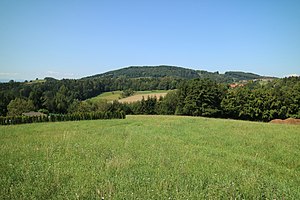Platte (Graz)
| plate | ||
|---|---|---|
|
Platte from the east (Fölling) |
||
| height | 651 m above sea level A. | |
| location | Graz , Styria , Austria | |
| Mountains | Grazer Bergland | |
| Dominance | 1.48 km → Lineckberg | |
| Notch height | 103 m ↓ 3rd plate cross | |
| Coordinates | 47 ° 6 '46 " N , 15 ° 28' 10" E | |
|
|
||
| rock | Slate , phyllite | |
| Age of the rock | Paleozoic | |
| particularities | Stephanienwarte ( AT ) | |
The plate is a 651 m above sea level. A. high elevation in the city of Graz . The summit is an approximately 1 hectare plateau, in the middle of which stands the Stephanienwarte , a former weather station. Today there is a modern environmental and air quality monitoring system on the tower. The elevation is open to tourists and offers a panorama of Graz from the Stephanienwarte.
Location and surroundings
The plate is located in the Mariatrost district in the Wenisbuch cadastral community . It rises around 250 m above the valley of the Mariatroster Bach and, together with the Pfangberg to the northwest, forms a small massif. A ridge of hills runs to the south-west to Rosenberg and Reinerkogel , in the north the Wenisbuch valley section separates the Lineckberg and Hauenstein elevations . In the southeast, the Rettenbachklamm separates the Platte from the Kogelberg . Access by car is possible via the Hinterer Plattenweg to a small parking lot at the 2nd Plattenkreuz, you can walk or bike up to the control room.
Stephanienwarte
In 1839 a wooden pavilion was built under the auspices of the accounting councilor Franz Göbel. At that time, the location was still in the Graz-Umgebung district . The first control room on the plate was designed by Wenzel Heger. Despite renovation work, it fell into complete disrepair in the following decades.
On April 6, 1880, the Styrian Mountain Association acquired the summit of the Platte along with a servitut that grants free access to the tower. JG Wolf's project emerged as the winning project from seven submissions for the new construction of the control room. The base and edges are made of broken stone, the sides are filled with red bricks. The 18-meter-high control room is entered through an archway: a ground floor in Renaissance style is followed by the middle floor with neo-baroque style elements. An iron grille with ornaments surrounds the viewing area and the tin roof rests on four iron columns.
After the laying of the foundation stone in July 1880, the Stephanienwarte opened on September 19th. In the 1950s a tower overseer kept things in order. In 1968 it was renovated and the Austrian Association of Experimental Broadcasters also used the control room for its own purposes. In 1972 the Graz Alpine Club section acquired a large area around the Stephanienwarte to protect it from construction.
From 1977 a radio control system of the state fire brigade association for disaster control was installed in the tower, which was relocated to the Plabutsch in 1995. Another renovation took place in 1979, and an air quality monitoring station was added in 1989, which was expanded in 1991 for ozone measurement. The Graz section of the Austrian Alpine Club is currently the owner of the Stephanienwarte, which has been freely accessible since 2010.
literature
- Renate Kniely: Lookout waiting around Graz . In: Historical yearbook of the city of Graz. Volume 38/39. Graz 2009. pp. 413-457.
Individual evidence
- ↑ a b Kniely: Outlook waiting around Graz , p. 441.
- ↑ Stephanienwarte / Platte on outdooractive.com
- ↑ a b Kniely: Outlook waiting around Graz , p. 444.
- ↑ Opening of the Stephanienwarte ( Memento of the original from April 7, 2014 in the Internet Archive ) Info: The archive link was inserted automatically and has not yet been checked. Please check the original and archive link according to the instructions and then remove this notice. , graz.at from August 9, 2010, accessed on March 31, 2014
- ↑ Kniely: Outlook waiting around Graz , p. 445.


